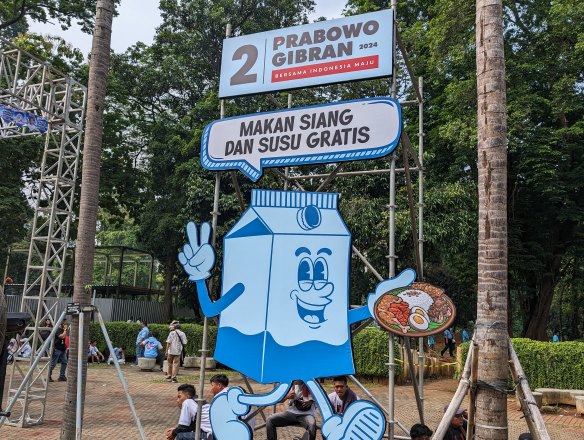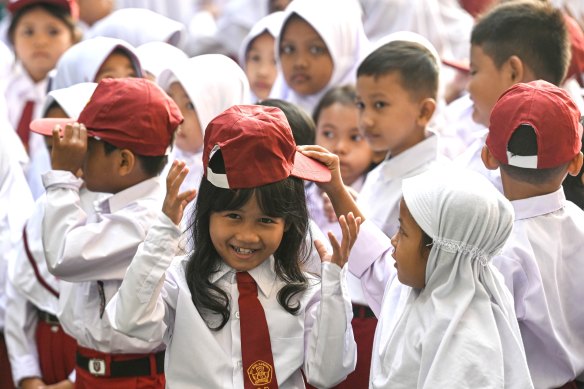- Analysis
- World
- Asia
- World elections
This was published 4 months ago
An election promise of free food may end up with fish milk on the menu
By Zach Hope and Karuni Rompies
What in the World, a free weekly newsletter from our foreign correspondents, is sent every Thursday. Below is an excerpt. Sign up to get the whole newsletter delivered to your inbox.
Greetings!
Fish milk, anyone?
Briefly this week, it appeared Indonesian president-elect Prabowo Subianto’s ungainly signature policy of free food had come to this – a rather unpleasant sounding but, we are assured, tasty substitute for the real deal.

“Free lunch and milk”: An election campaign poster outside a Prabowo Subianto rally before the February election. Credit: Zach Hope
To be sure, susu ikan, as it is called in the local language, is not actually milk pumped from a fish; rather, it is an extract of sorts, rich in piscatorial goodness and made from a complex process of mincing the flesh then churning, whizzing and mixing with sorcery far beyond this author’s comprehension (if you’re keen, you can read about how it’s made here).
For now, the good stuff only comes in strawberry flavour, but chocolate and “plain” (milk-flavoured milk?) are in the works, all backed by the government, which hopes to squeeze more value out of Indonesia’s vast fish resources.
Until a few days ago, the state-owned manufacturing company was touting susu ikan as a stopgap that may allow Prabowo to keep his election pledge of providing free daily milk for toddlers, and meals (milk plus meat) for schoolchildren and breastfeeding mothers. These cohorts total some 83 million people, though the figures, like the policy, are a little foggy.
The idea, already in place in other developing countries including India, is to help children through school and reduce malnourishment that stunts about one in five Indonesian toddlers. The demand for local produce will also benefit farmers, cooperatives and village enterprises, says Fakhridho Susilo from advisory firm BowerGroupAsia, “though no formal study is yet to come out on how big of an impact”.
As you can imagine, the cost of providing all these meals with proper milk and meat is eye-watering. In a fully realised form by 2029, it could cost about $44 billion per annum. This would be almost 2 per cent of Indonesia’s GDP, and more than double its current health budget.
Pundits quite reasonably question whether the nation can afford it.

Students attend orientation on the first day of the school year at Ciater elementary school in South Tangerang, Banten Province, Indonesia, on July 15.Credit: Xinhua News Agency via Getty Images
Regardless of where the costs land, it has nowhere near enough domestically produced milk as it is. Once free milk starts flowing in the classrooms, the national requirements may double.
This is how fish milk for lunch – like the full meal plan itself: ambitious, interesting and unlikely – made its debut in Indonesian headlines.
As the cool technology story began taking hold, and bigwigs from the susu ikan company posed for pictures, National Nutrition Agency chief Dadan Hindayana cooled everyone’s jets by saying the government was “not yet” going down that fishy path.
Instead, it would keep to its plan and import dairy cattle in stages to boost domestic supply. While Dadan did not say just how many cows would be needed, reports in local media generally put the figure somewhere between 1.5 million and 2.5 million. Any number would take time, though, hence the need for a stopgap – and significant money. There’s also the issue of land.
Prabowo’s freebie policy was light on detail at the election. More than six months later, as he prepares to take over from Joko Widodo next month, it still is.
But it was a hit with voters. That’s what mattered at the time. Now the election is run and won, Prabowo and his incoming team face the burden of big-spruiking politicians around the world: delivery.
Indonesia, with its thousands of islands, is a logistical nightmare. Where will the food be prepared, and how will it get to schools and mums? Dadan’s nutrition agency plans to set up 100 “service units” across the country, but the details are not well known.
Some have proposed using delivery drivers from Gojek, which is like Uber, for food runs, but the company doesn’t operate everywhere throughout the nation.
Australian milk and beef producers are licking their lips in anticipation, though no one in either country knows how much the Indonesians will need to import.
Amusingly, the “lunch” element in the program has been changed to “free nutritious meal” after someone realised that many schools actually ring the final bell about noon. Lunch will probably now be breakfast.
Then there’s the money. “A social welfare project of this scale presents the risk of corruption,” warns BowerGroupAsia’s Susilo. “As such, there needs to be stringent transparency and accountability measures set in place.”
At a budget level, Prabowo has broadly committed to push ahead with Nusantara, the new capital city that Jokowi, as his predecessor is widely known, started building in the malarial jungles of Borneo. This will cost roughly the same amount as a fully-fledged free meal program, but at least a city only gets built once.
The annual $44 billion meal plan bill would blow the mandated maximum budget deficit of 3 per cent of GDP, a law brought in after the disaster of the Asian financial crisis of the late ’90s. Accordingly, the meal budget has been repeatedly revised down. Only select regions will be targeted in the first year (2025) and for this the outgoing and incoming administrations have agreed to a budget of close to $7 billion.
What happens beyond next year is unclear. There are no forward estimates. But the continuation of this relatively small allocation would mean a very different meal program to what was intended.
Prabowo is seeking to dramatically grow state revenue. At the same time, he may choose to break with Joko’s conservative approach to debt and expand it over years from 39 per cent of GDP to 50 per cent (the laws cap it at 60 per cent). He may find cheap, local food substitutes (fish milk, say?). He will probably need to slash other parts of the budget.
Meals to help children and poor families is a worthy aspiration, but there are many ingredients still missing.
Get a note directly from our foreign correspondents on what’s making headlines around the world. Sign up for the weekly What in the World newsletter here.